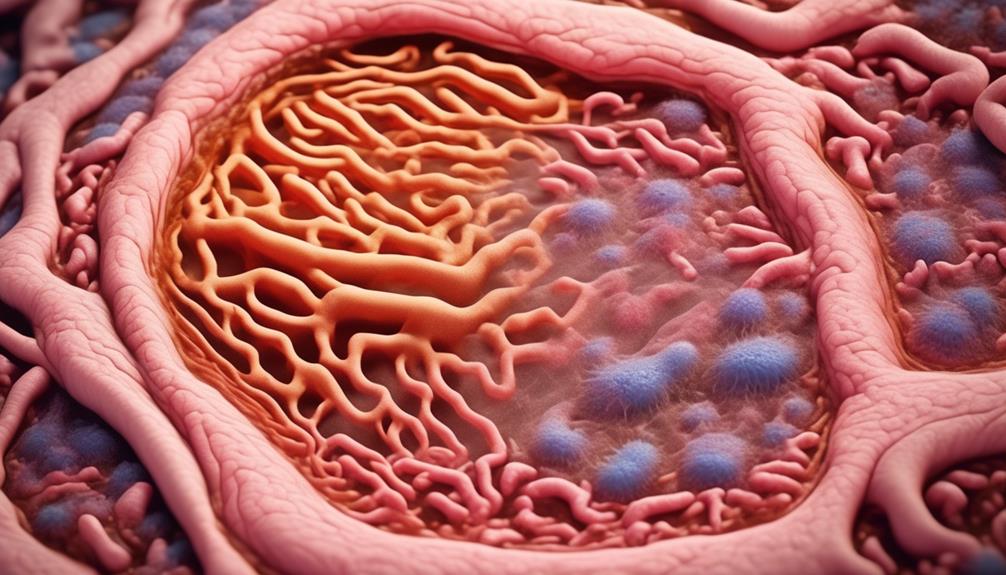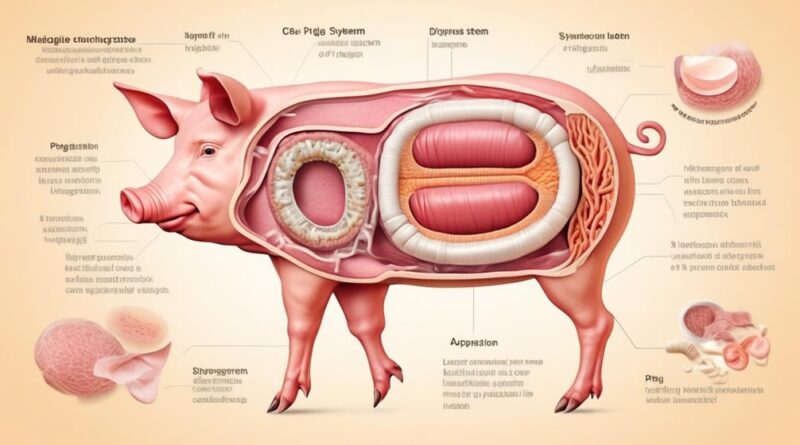What Are the Functions of a Pig's Digestive System?
Imagine a pig's digestive system as a finely tuned orchestra, each organ and process playing a crucial role in the symphony of digestion.
From the moment food enters the mouth to the final elimination of waste, the pig's digestive system carries out a series of complex functions that are essential for its survival.
But have you ever stopped to wonder just what exactly these functions are, and how they all work together to sustain the life of a pig?
Let's explore the intricate workings of a pig's digestive system and uncover the fascinating functions that keep these animals healthy and thriving.
Digestive Structure
Understanding the pig's digestive structure is essential for comprehending its overall digestive functions and processes. The pig's digestive system structure is designed to efficiently process a variety of foods. It begins with the stomach, where food is broken down by stomach acid and digestive enzymes. The pig's stomach plays a vital role in the initial stages of digestion, preparing food for further breakdown and absorption.
Moving beyond the stomach, the small intestine anatomy is crucial for nutrient absorption. The small intestine is where the majority of nutrient absorption takes place, allowing the pig's digestive system to extract essential nutrients from food.
In understanding the pig's digestive physiology, it's essential to recognize its digestive system function. The pig digestion process is highly efficient, enabling the animal to derive maximum nutritional benefit from its diet. The digestive health of pigs is directly linked to the functionality of their digestive system. Maintaining a balanced and healthy diet is crucial for optimal digestive health in pigs.
Ingestion and Chewing
The efficient breakdown of food in the pig's stomach sets the stage for the crucial processes of ingestion and chewing in the digestive system. When it comes to swine diet, pigs are known for their omnivorous nature, consuming a wide variety of foods including grains, fruits, and vegetables.
Here's how ingestion and chewing play a vital role in the pig's digestive process:
- Efficient Ingestion: Pigs are known to be voracious eaters, often consuming large quantities of food. Their well-developed snouts and strong facial muscles enable them to root and dig for food, facilitating efficient ingestion. This behavior is essential for their dietary needs, allowing them to obtain the necessary nutrients from a range of food sources.
- *Dental Health*: Adequate chewing is crucial for a pig's dental health. Pigs have a unique dental structure, with a total of 44 teeth. Their powerful jaws and teeth are well-suited for grinding and crushing their food, aiding in the initial breakdown of feedstuffs. Proper chewing also promotes saliva production, which contains enzymes that begin the digestion process in the mouth.
Enzymatic Breakdown
Enzymes in the pig's digestive system actively break down food particles, aiding in the absorption of nutrients and promoting efficient digestion. Chemical processes play a crucial role in the enzymatic breakdown of food.
As food moves through the pig's digestive tract, various enzymes such as amylase, lipase, and protease are secreted at different stages to initiate the breakdown of carbohydrates, fats, and proteins, respectively.
The enzymatic breakdown begins in the mouth, where the enzyme amylase starts breaking down starches in the ingested food. Once the food reaches the stomach, it encounters gastric juices that contain hydrochloric acid and pepsin, which work together to further break down proteins into smaller peptides. This chemical process prepares the food for the next stage of digestion in the small intestine.
In the small intestine, the pancreas secretes enzymes such as lipase, amylase, and various proteases to continue the breakdown of fats, carbohydrates, and proteins. These enzymes facilitate the chemical processes that break down complex molecules into simpler forms that can be absorbed by the intestinal lining.
The breakdown of food into its basic components is essential for the pig's body to extract and utilize nutrients effectively.
Absorption of Nutrients
In the pig's digestive system, once the enzymatic breakdown of food particles has occurred, the next crucial step is the absorption of nutrients. This process takes place in the small intestine, where the majority of nutrient absorption occurs. The small intestine is lined with tiny, finger-like projections called villi, which significantly increase its surface area for absorption.
Here's what happens during the absorption of nutrients:
- Nutrient Absorption:
The villi are covered with even smaller hair-like structures called microvilli, which further increase the surface area available for absorption. This extensive surface area allows for the efficient absorption of nutrients such as sugars, amino acids, fatty acids, vitamins, and minerals from the digested food.
- Nutrient Utilization:
Once absorbed, these nutrients are transported through the bloodstream to various cells and tissues throughout the pig's body. The cells utilize these nutrients for energy production, growth, repair, and maintenance of bodily functions. For instance, sugars are used as an immediate source of energy, amino acids are used for protein synthesis, and fatty acids are utilized for energy or stored as fat for future energy needs.
Fermentation Process
During the fermentation process, your pig's digestive system breaks down complex carbohydrates into simpler compounds through the action of beneficial microbes. This process primarily takes place in the pig's large intestine, where the gut microbiota play a crucial role in breaking down dietary fiber and other indigestible components of feed through fermentation.
The gut microbiota encompass a diverse community of microorganisms, including bacteria, protozoa, fungi, and archaea, which work together to ferment feed and produce short-chain fatty acids (SCFAs) as byproducts.
Feed fermentation in the pig's digestive system is essential for the breakdown of plant cell wall components, such as cellulose and hemicellulose, which can't be digested by the pig's own enzymes. The gut microbiota ferment these complex carbohydrates, converting them into SCFAs, including acetate, propionate, and butyrate. These SCFAs serve as an energy source for the pig and play a vital role in maintaining the health of the intestinal epithelium. Additionally, they contribute to the overall energy balance of the pig by being absorbed and utilized as a source of energy.
The fermentation process also aids in the synthesis of certain vitamins, such as vitamin K and certain B vitamins, by the gut microbiota. Furthermore, it helps in the elimination of antinutritional factors and the production of microbial proteins that can be digested and absorbed by the pig.
Waste Elimination
The efficient elimination of waste is a crucial function of your pig's digestive system, ensuring the removal of indigestible material and byproducts from the body. This process is primarily managed by the excretory system, which encompasses the large intestine and rectum.
Here's how waste elimination works in your pig's digestive system:
- Fecal Matter Formation:
Once the nutrients from the ingested food have been absorbed, the remaining indigestible material moves into the large intestine. Here, water is reabsorbed, and the waste is formed into fecal matter. The fecal matter consists of undigested food, bacteria, mucus, and dead cells.
- Elimination Process:
As the fecal matter moves through the large intestine, it continues to solidify. It's then stored in the rectum until your pig is ready to eliminate it. When the rectum is full, nerve endings send signals to the brain, triggering the urge to defecate. Your pig will then expel the fecal matter through the anus, completing the waste elimination process.
The excretory system plays a vital role in maintaining your pig's overall health by removing waste products that could be harmful if retained in the body. Understanding the waste elimination process can help you monitor your pig's digestive health and ensure that it's functioning properly.
Microbial Role

Facilitating the breakdown of complex compounds, microbes in your pig's digestive system play a crucial role in aiding the digestion of food. Within the gut microbiota, microbial symbiosis contributes to the fermentation process, which is essential for the breakdown of otherwise indigestible components of the pig's diet. This symbiotic relationship allows the pig to derive nutrients from sources that its own digestive enzymes can't break down.
The fermentation process, driven by the gut microbiota, is particularly important in the pig's large intestine. Here, microbial diversity ensures that a wide range of dietary components, such as fibers and polysaccharides, are broken down through fermentation. This process yields short-chain fatty acids and other by-products that the pig can absorb and utilize for energy.
Moreover, the gut microbiota assists in the synthesis of certain vitamins and amino acids that are crucial for the pig's overall health. For instance, some microbes in the digestive system are capable of synthesizing vitamins B and K, which are then absorbed by the pig.
In essence, the microbial community within the pig's digestive system is integral to the animal's ability to derive energy and nutrients from its diet. By breaking down complex compounds and aiding in the synthesis of essential nutrients, these microbes play a vital role in maintaining the pig's overall health and well-being.
Regulation of Digestion
In order for your pig's digestive system to function properly, the regulation of digestion is essential for maintaining optimal nutrient absorption and overall health.
The regulation of acidity, gut motility, and peristalsis are crucial components in ensuring that your pig's digestive system operates efficiently.
- Regulation of Acidity
Maintaining the right level of acidity in the stomach is essential for proper digestion. The pig's stomach produces hydrochloric acid, which helps break down food and kill harmful bacteria. The regulation of this acidity ensures that the stomach environment is conducive to the digestive enzymes' activity and the overall digestive process.
- Gut Motility and Peristalsis
Gut motility refers to the movements of the digestive system that facilitate the mixing and passage of food. Peristalsis, a specific type of gut motility, involves rhythmic contractions that propel food through the digestive tract. These movements are essential for the proper digestion and absorption of nutrients. Regulation of gut motility and peristalsis ensures that food moves through the digestive system at the right pace, allowing for thorough digestion and absorption of nutrients.
Frequently Asked Questions
Can Pigs Regurgitate Their Food Like Some Other Animals?
Yes, some animals, like ruminants, can regurgitate their food as a part of their digestive process. This is a unique feature of their animal physiology that aids in digestion. Pigs, however, do not have this regurgitation ability.
How Does the Pig's Digestive System Differ From Other Farm Animals Like Cows or Chickens?
When comparing the digestive anatomy of pigs to cows or chickens, consider their unique nutritional and dietary requirements. Pigs have a monogastric digestive system, while cows and chickens have a ruminant digestive system.
What Role Does the Pig's Diet Play in the Overall Function of Its Digestive System?
Your pig's diet plays a crucial role in the function of its digestive system. Enzymes aid in breaking down food, and meeting nutritional requirements ensures proper digestion. Understanding these factors is essential for maintaining your pig's health.
Do Pigs Have a Specific Stomach Structure That Helps Them Digest Certain Types of Food?
Yes, pigs have a specific stomach structure that helps them digest certain types of food. Their stomach produces digestive enzymes, aiding in food breakdown and nutrient absorption. Digestive health issues can be treated with appropriate options.
Are There Common Digestive Health Issues That Pigs May Experience, and How Are They Treated?
If your pig experiences digestive health issues, treatment options include dietary management and medication. Common digestive issues in pigs may include diarrhea, constipation, and gastric ulcers, which can be addressed with proper care and veterinary guidance.
Conclusion
So, as you can see, a pig's digestive system is a complex and efficient process.
From the ingestion and chewing of food to the enzymatic breakdown and absorption of nutrients, every step plays a crucial role in the pig's overall health and well-being.
The fermentation process, waste elimination, and microbial role further contribute to the efficient functioning of the digestive system.
Overall, the digestive system of a pig is essential for their survival and overall health.
